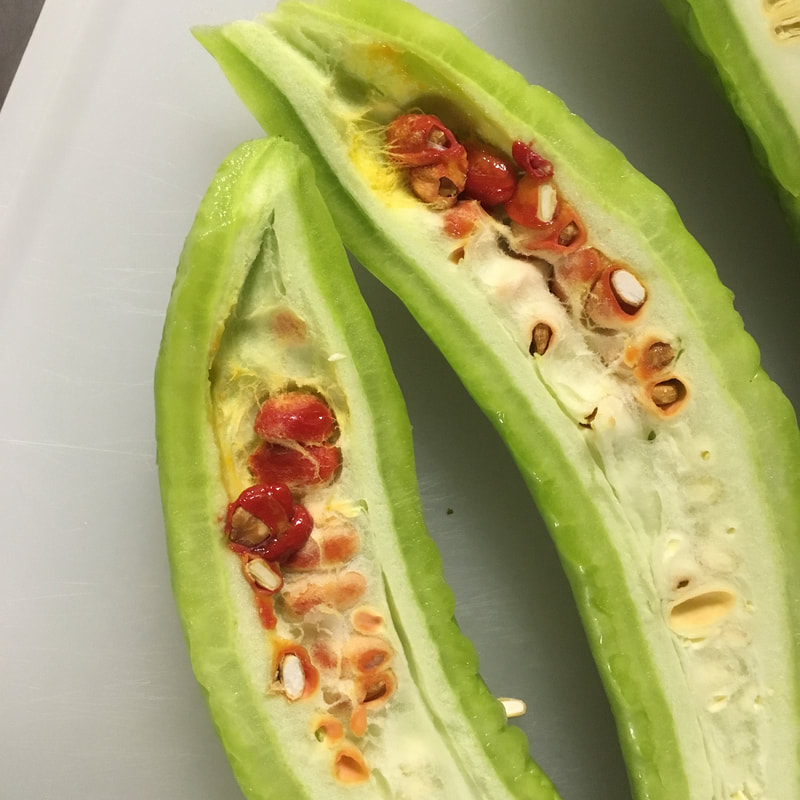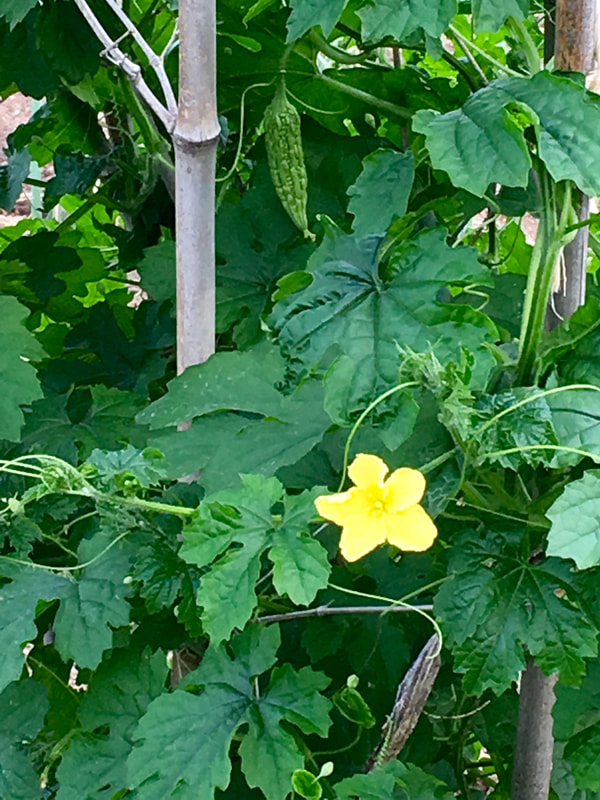|
Have you ever cut into a bitter melon and found bright red goop inside? Yes, it is edible!
The bitter melon is nicknamed "magic melon" because of numerous health benefits (see last week's post), but I think the transformation that happens inside as the fruit matures is also a bit magical. As you may know, the usable part of the bitter melon is the green, bumpy outside part. See the spongy white part inside? We scoop it out and discard it. However, as the melon matures, the spongy white stuff turns into goopy red stuff and here's the best part - it's sweet! It's always a fun surprise to cut open a bitter melon to find the insides have begun to turn red. The texture is a bit like roasted red pepper and it is sweet and edible. Just be sure to spit out the seeds when enjoying this little treat!
17 Comments
Can you see the small bitter melon growing near the top of the photo? We grow it because it tastes good (really!), but what a lot of people know now, is that it's very healthful as well.
Research has shown that bitter melon contains a chemical that is similar to insulin, which helps to reduce blood sugar levels. While several years ago, the majority of participants at my talks and workshops had not heard of bitter melon, today, a good 75% have. A few participants have been advised by their doctors and nutritionists to add bitter melon (in vegetable or pill form) to their diets to help with diabetes. Many people have told me they don't mind the bitter taste, and many have even mentioned that they enjoy the cooling bitterness. One person told me she adds bitter melon to her green juices and does not even taste it - I find this hard to believe, but she insisted! It might be similar to kale in that when juiced with fruits, it blends in with the rest of the sweet, fruity flavors. Bitter melon is also known to ease stomach and digestive issues, fever and skin problems. With all these health benefits, it's something everyone ought to try once. You may just end up loving it! *If you're curious about adding bitter melon to your diet to help with a medical condition, speak with your doctor or nutritionist for suggestions about dosages. **If you're curious about adding this delicious vegetable to your diet because you want to see what all the fuss is about, try the recipe in The Chinese Kitchen Garden. The strong flavors of garlic and fermented black beans balance the bitterness of the bitter melon and result a savory and hearty meal served over rice. The short answer is yes, you can eat bottle gourds! But as you may know, these are the same items that, left on the vine to dry, will hollow out and can then be made into birdhouses! Here are some instructions by Birds and Bloom should you wish to make your own birdhouse out of a dried gourd.
For eating, young gourds picked far from maturity, are best. This is when the gourd can be peeled and then split open to reveal off-white flesh. Most people prefer to remove the spongy center along with all the seeds. What remains can be cut into chunks and cooked how you like it! The photo below shows a type of bottle gourd that I prefer for eating over the birdhouse-shaped type. This gourd is eaten all over the world and goes by many names. In markets near me, they're often labelled "long squash". A couple weeks ago, I had the pleasure of speaking at a panel discussion at the Museum of Chinese America in New York. There is a excellent exhibit going on called Sour, Sweet, Bitter, Spicy, and if you've found your way to this blog, I know you will love the exhibit. It runs through September 10th so your time is limited. I highly recommend a visit!
Anyhow, at the discussion, I was asked about fall gardening. What do gardeners need to know about it??? Well, take a look at the photo above, which was probably taken...October maybe? Tomatoes and other fruiting vegetables are dead and brown. But see the greenery? The tall dark green plants are a giant bunching onion called "da tsung". The shorter green plants, and the chartreuse greens behind them are the gems of fall - Asian greens such as tatsoi and A choy. What gardeners need to know about fall planting is that it needs to be well thought out and planned in advance. Fall gardens don't just happen. Most of the time, in the heat of the summer, fall-planting gardeners are going through seed packets, anticipating where there will be space in the garden, and figuring out when and how to start each type of vegetable seed. My biggest challenge, personally? Germinating seeds and keeping them from drying out. A good solution for my situation is starting my fall leafy greens indoors. This way I can keep an eye on them and water them regularly without worrying that a late high 90 degrees day will kill them. This also lets me keep plants like beans for shelling or gourds for drying, on the vine in the garden as long as possible. With a little preparation, it's easy to have a fantastic garden far into the fall. Lots of Chinese vegetables actually taste better after they're hit with a frost. Tatsoi, like carrots, become sweeter as the weather cools. Get a copy of The Chinese Kitchen Garden now and learn about all the leafy greens that are at their best in just a couple of months! |
AuthorI'm Wendy Kiang-Spray, gardener, home cook, and author of The Chinese Kitchen Garden. Learn more about the book here. Enjoy the blog and be sure to like The Chinese Kitchen Garden Facebook page for notifications when there are new posts. Archives
April 2019
Categories
All
|





 RSS Feed
RSS Feed